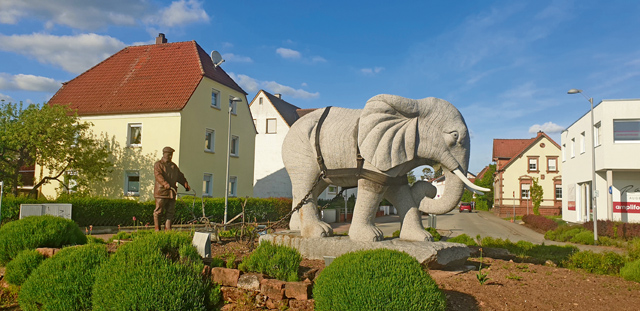
Anyone that has traveled to Alsenborn is sure to have encountered a giant elephant pulling a plow in a traffic circle leading into the village. Thinking about elephants you may picture herds of the mighty gray animals roaming the savannahs of Africa. Working elephants carrying large logs with their trunks in Asia or colorfully painted ones hauling tourists around India may come to your mind. But, an elephant pulling a plow with a farmer tagging along behind is definitely an uncommon sight.
Elephants can be seen in zoos and are sometimes taught tricks to delight circus visitors. This brings us somewhat closer to revealing the story behind our elephant. Similar to the wandering musicians in the Westpfalz region, there were numerous folks from Alsenborn who roamed the countryside as traveling circuses in the late 1850’s and beyond. Some made livings as musicians, marionette players, acrobats or animal tamers and Alsenborn is commonly referred to as the “home of rope dancers” or “Bajasse,” an Italian name for their trade.
Since the circus folk mainly traveled during the summer months, they needed a place to stay during the dreary and cold winters. Farmers, on the other hand, couldn’t till or work their fields, and allowed the circuses to use them as winter camps.
One of the few circus families that found a permanent home in Alsenborn was circus director Andreas Bügler who had six children. These were known as the best circus artists of the time, particularly famous for their rope acts. Son Jeromy then married Magdalena Althoff who brought the oldest circus dynasty in Germany to Alsenborn in 1883.
The Bajasseum is a tiny museum that resembles a circus tent and focuses on the overall theme. It is located on the main road in the former sandstone fire department building. The annual village festival in September is named the “Bajasse Kerwe” where you just might encounter a mini elephant or a few clowns in the parade on Sunday.
A clown is also pictured on the town hall fountain on the other side of the train tracks. Enkenbach. Enkenbach-Alsenborn has also been chosen as honorary town in the Musikantenland Westpfalz program to promote cultural and musical projects.
Back to our industrious elephant, farmers provided winter homes to the artists, musicians and circus animals and supplied them with nutrition and hay. The elephants who amazed spectators in the summer, but rested in winter, were grateful to pay back and assist farmers with pulling plows to till their fields and in return provide produce to the residents in Alsenborn. Our symbolic elephant was just one of the many, but most certainly carrying out an easy task for a mighty gray tusker.
Alsenborn will be hosting its annual “Bajazze Kerwe” (village festival) from Sep. 2–5, with the parade on Sunday afternoon. Don’t miss out on the fun!


